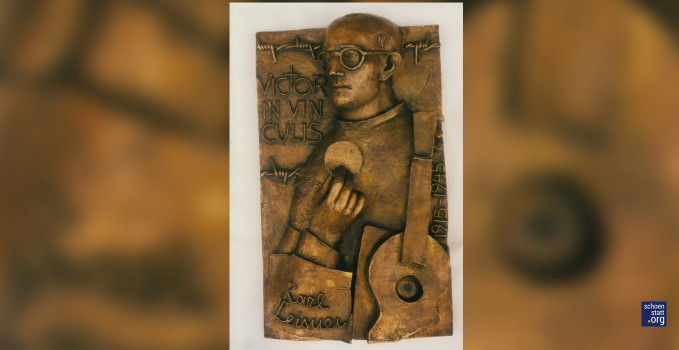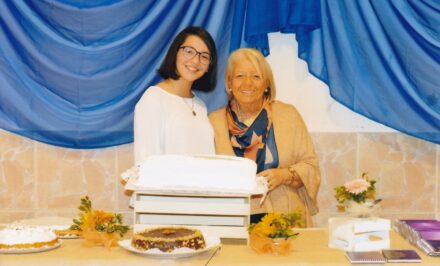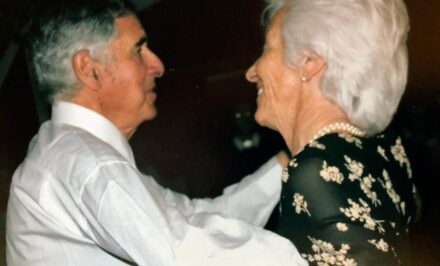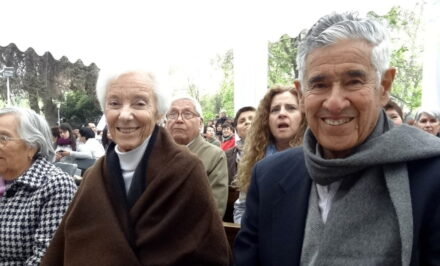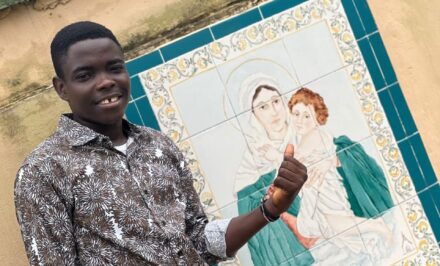By Msgr Peter Wolf, DD •
Today, the 23 July, twenty years will have passed since Pope John Paul II beatified Karl Leisner in the Olympic Stadium in Berlin. I was present and can recall how at the beginning of the Mass the Bishop of Munster, obviously departing from the planned programme, introduced Karl with enthusiastic and engaging words. In his sermon the Holy Father quoted from Karl’s diary and spoke about his relationship to Schoenstatt. He said, “Even before he was imprisoned in Dachau he had developed deep devotion to Mary, to which he was inspired by Fr Kentenich and the Schoenstatt Movement. His faith, courage and enthusiasm for Christ can be an incentive and example to young people who are living in a world largely marked by lack of faith and indifference.”
Guitar and priest’s host
In the context of the beatification the Uniti Patri Course took the initiative to make the new Blessed present in our Moriah Shrine. Before the beatification we had the well-known photo of Karl in a pullover, which was taken in the concentration camp, in our Dachau chapel. Our confreres asked how Blessed Karl Leisner should be depicted in the time to come. Christian iconography has for centuries shown a saint in connection with certain personal characteristics. The priests in the course wanted to make a suggestion in this regard with their picture.
The discussion arrived at the conclusion that Karl was characterised in his lifetime by two symbols: the guitar and the priest’s host. Even as a youth and seminarian Karl spent years leading groups with great enthusiasm, and organising youth camps. He was able to enkindle enthusiasm in others and carry them with him – something that attracted the attention of the Gestapo. He was so fond of his guitar that he even had it sent to him in the concentration camp so that he could cheer up the sick and other prisoners with his playing. The priest’s host in his hand stands for his love and enthusiasm for Christ. For years he prepared himself for his priestly vocation and struggled to follow it. In the camp his longing was fulfilled. His ordination became possible through another prisoner, Bishop Gabriel Piguet.
Victor in chains
In the bronze sculpture by the Munich artist, Johannes Potzler, two further signs were added to make Karl’s attachment to Schoenstatt visible. First of all, there are the words VICTOR IN VINCULIS engraved at the top of the picture. It was the ideal of the Schoenstatt group to which Karl belonged in the camp in 1943. These words can also be seen on the bishop’s crosier that was carved for the ordination ceremony in the camp, and which the Pope held during the beatification. At the bottom left we can see the name of the new Blessed. The artist deliberately copied Karl’s handwriting. Thus his name is like a signature at the bottom of an empty page to signify the Blank Cheque consecration, which his seminary group in Munster had entered into in the Original Shrine in Schoenstatt. Karl repeatedly saw his arrest and imprisonment in the context of the Blank Cheque he had given the Blessed Mother. For me personally, it is a telling sign that Schoenstatt’s spirituality played an essential part in making Karl a saint.
May the day of his beatification invite us to strive again and again for this readiness and total self-surrender from which Blessed Karl Leisner lived.
Photo: Fr. Benjamin Hoch


